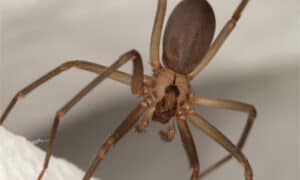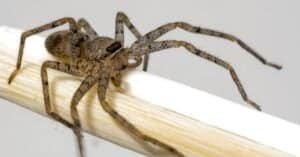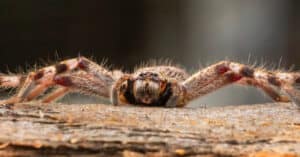New Mexico is a state of many nicknames, many of which reference its natural beauty. While officially known as the Land of Enchantment, you may know it better as the Sunshine State or the Cactus State. Both of these names are obvious, given its dry, desert climate as well as the abundance of cacti. However, you’d be remiss not to also associate the state with the many animals that live there, including mountain lions and peccaries. The state is also home to many unique species of spiders. From tarantulas to jumping spiders, you can find a whole slew of spiders in New Mexico. Here is a list of 10 spiders that you can find in the Land of Enchantment.
#10. Southern House Spider
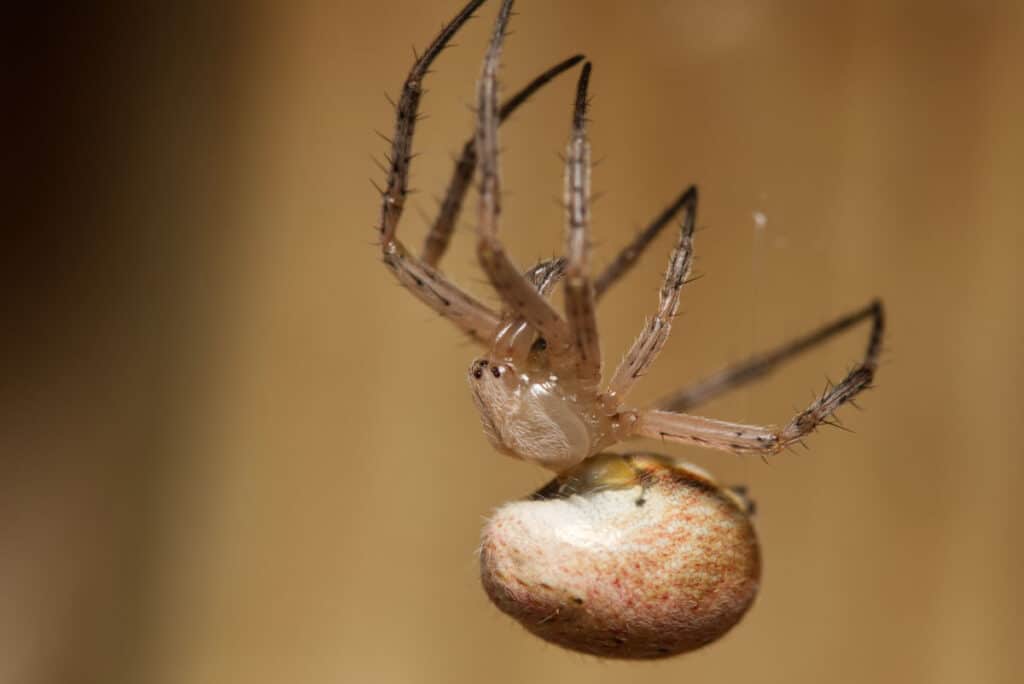
Southern house spiders often get mistaken for brown recluses due to their similar markings.
©Kala Stuwe/Shutterstock.com
The southern house spider, Kukulcania hibernalis, belongs to the crevice weaver family Filistatidae. It is one of the most common spiders in New Mexico and also ranges throughout much of the southern United States, the Caribbean, and South America.
Most southern house spider species display sexual dimorphism, meaning that the females and males look different from each other. For example, female spiders tend to measure larger than males in most species. However, southern house spiders buck this trend, as the males and females measure around the same size. With their legs extended, they average around 50 mm long. That said, males tend to possess longer legs, while females have more bulbous abdomens. Both sexes appear predominantly brown, although males look lighter than females.
Southern house spiders build radial-style, non-sticky webs that they use to ensnare prey. They are not known to be aggressive, and they pose little danger to humans.
#9. Tucson Bronze Tarantula
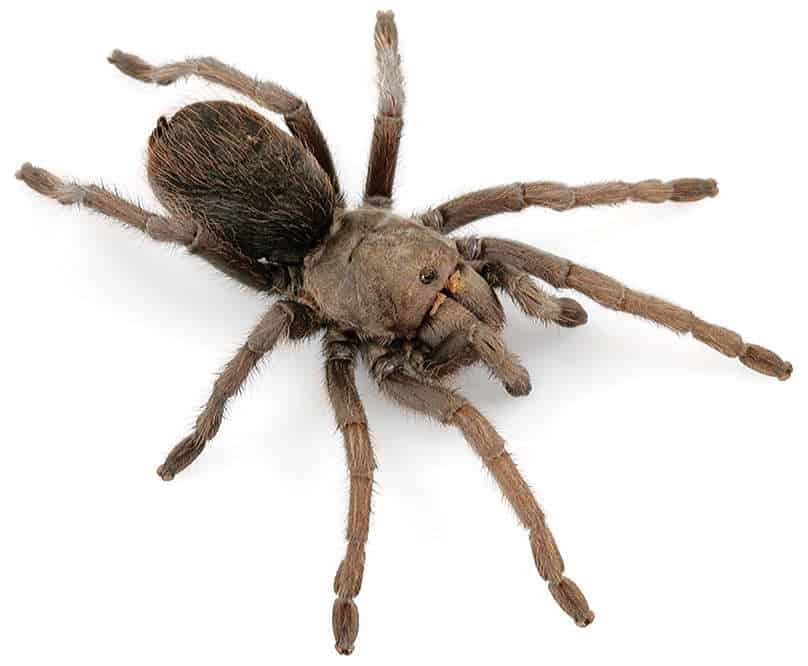
Female Tucson bronze tarantulas can live up to 15 years.
©Chris A. Hamilton, Brent E. Hendrixson, Jason E. Bond / Creative Commons – License
Aphonopelma virhiesi, or the Tucson bronze tarantula, belongs to the tarantula family Theraphosidae. You can find this large spider in New Mexico as well as several of the surrounding states, including Arizona, hence its name.
Tucson bronze tarantulas can grow between 3 and 5 inches long with their legs extended. Generally, females tend to measure larger than males. They appear mostly light brown or bronze in color, which is where they get their name.
You are most likely to encounter Tucson bronze tarantulas in deserts and scrubland areas. Rather than using webs, they actively hunt for prey at night when prey is plentiful, and predators are less present. These spiders make popular pets due to their rather docile nature and long lifespan. Females can live for up to 15 years, while males tend not to live as long as females.
#8. Desert Red Jumping Spider
The desert red jumping spider, Phidippus ardens, belongs to the jumping spider family Salticidae. It is widely distributed throughout the United States and Mexico, although it tends to live in dry or desert regions, hence its name.
Female desert red jumping spiders can grow up to 18 millimeters long, while males tend to measure slightly smaller. They often get confused for red-backed jumping spiders due to their similar appearance. Their cephalothorax and legs appear grey-black, while the abdomen looks bright reddish-orange. Most specimens feature a black median line near the rear of the abdomen. Additionally, these spiders sport large, metallic green or blue mouthparts (chelicerae).
Like other jumping spiders, desert red jumping spiders hunt by using their keen eyesight and jumping ability. While they are prolific hunters, they pose little to no threat to humans, as their bite is not medically significant.
#7. Geolycosa Missouriensis
In English, Geolycosa missouriensis’s name translates roughly to the “Missouri burrowing wolf spider.” It belongs to the genus Geolycosa, or burrowing wolf spiders, in the family Lycosidae. You can find this spider in New Mexico as well as throughout much of the central and western United States and Canada.
Most adult specimens measure between 18 and 22 mm long, with females measuring larger than males. They come in various shades of brown, grey, tan, yellow, or orange and tend to look mostly uniform in color. However, they can feature darker bands on the legs.
As its name implies, Geolycosa missouriensis builds a burrow in the ground that it uses to hide from predators and prey. When insects wander too close, it will dart out from its burrow and snatch its target with its powerful jaws and legs. Since this spider prefers to burrow in the ground, you’ll rarely find it indoors.
#6. Western Parson Spider
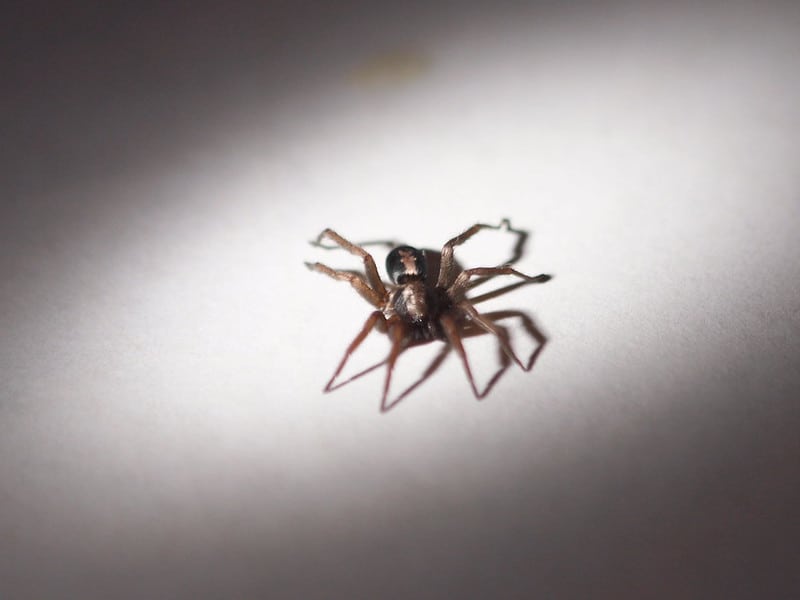
The western parson spider has a marking that looks like a cravat worn by 18th-century members of the clergy.
©lostinfog, CC BY-SA 2.0 <https://creativecommons.org/licenses/by-sa/2.0>, via Wikimedia Commons – License
The western parson spider, Herpyllus propinquss, belongs to the ground spider family Gnaphosidae. It ranges throughout the western United States as well as parts of Canada and Mexico. If you want to find western parson spiders in New Mexico, you’re most likely to encounter them under rocks or logs in forests and occasionally in your home.
Adult western parson spiders measure between 10 and 20 millimeters long, with females measuring larger than males. Their bodies appear mostly black or dark grey aside from some distinctive white markings on the abdomen. These markings resemble the 18th-century cravats worn by members of the clergy or parsons, hence their name.
Like other members of its family, the western parson spider does not use a web to capture prey. Instead, it relies on its quick speed to chase down fleeing insects. While its bite poses little danger to humans, it can be quite painful.
#5. Golden Silk Orb Weaver
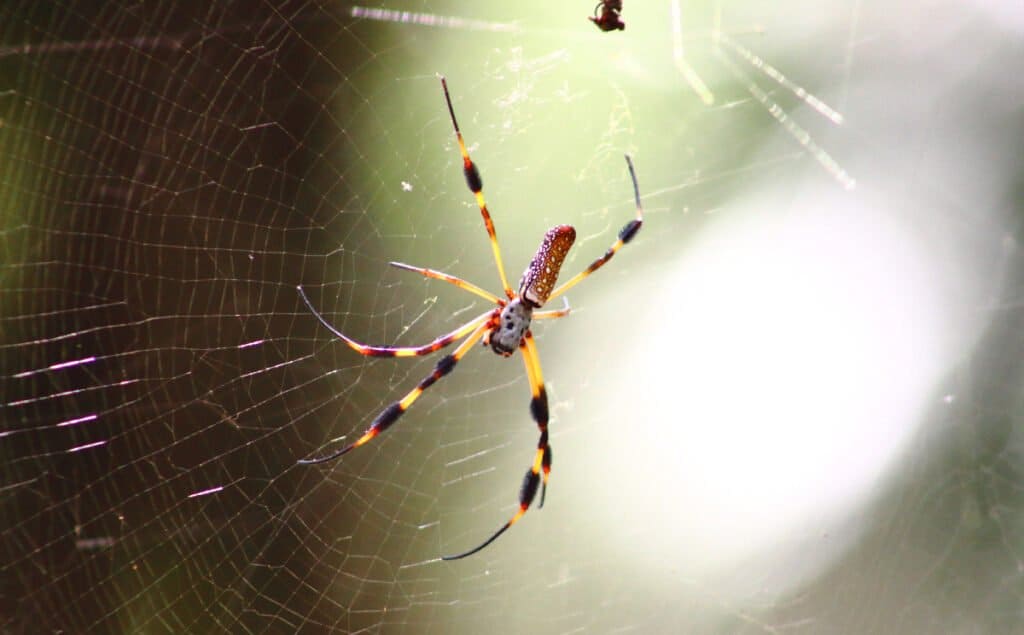
The golden silk orb weaver builds a web that measures nearly 5 feet in diameter.
©Max Rossa/Shutterstock.com
Trichonephila clavipes, or the golden silk orb weaver, is one of the most misunderstood spiders in New Mexico. This is because it also goes by the name banana spider, so it often gets confused with the venomous Brazilian banana spider. It ranges throughout the southern United States and as far south as Argentina.
Adult female golden silk orb weavers can measure between 24 and 40 millimeters long, making them one of the largest orb weavers in the United States. Meanwhile, males measure much smaller at only around 6 millimeters long. They have a characteristic silvery-white cephalothorax and an orangish-brown abdomen that features two rows of white dots.
Golden silk orb weavers build webs measuring up to five feet wide in order to catch their prey. They can produce seven different types of silk, which often appear yellowish-gold in the sunlight, hence their name. Despite their large size, they pose little threat to humans.
#4. Chiricahuan Grey Tarantula
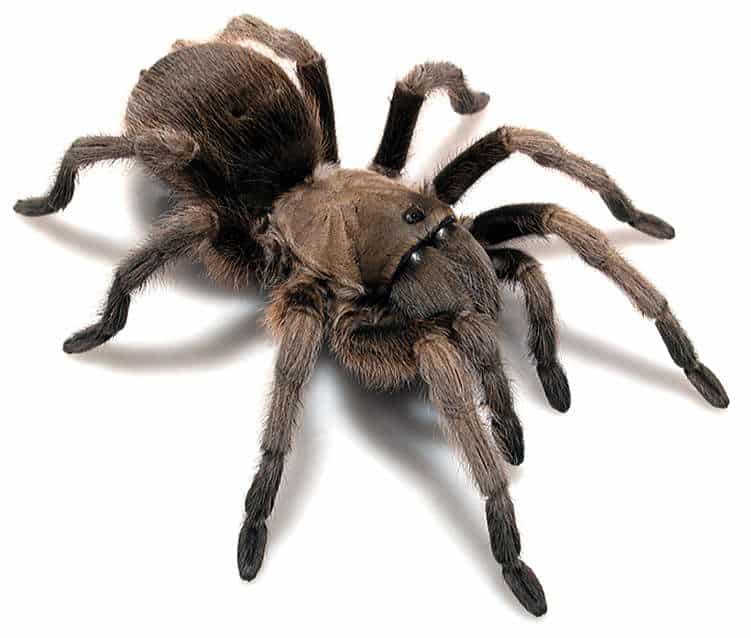
The Chiricahuan grey tarantula can measure up to six inches long.
©Chris A. Hamilton, Brent E. Hendrixson, Jason E. Bond / Creative Commons – License
The Chiricahuan grey tarantula, Aphonopelma gabeli, is the second tarantula to make our list of spiders in New Mexico. Also known as the Carlsbad green tarantula, its range extends throughout the southwestern United States and parts of Mexico.
Adult specimens usually measure around 5 inches long but can reach up to 6 inches at the longest. In terms of appearance, they look mostly brown, black, or grey. That said, they can appear greyish-green shortly after molting, hence their name.
Chiricahuan grey tarantulas prefer to live in dry, arid soil, as this terrain is perfect for them to build their burrows. During the day, they hide in their burrows to avoid predators and the hot sun. At night, they wait near the entrance of their burrows and ambush prey that wanders too close.
#3. Giant Crab Spider
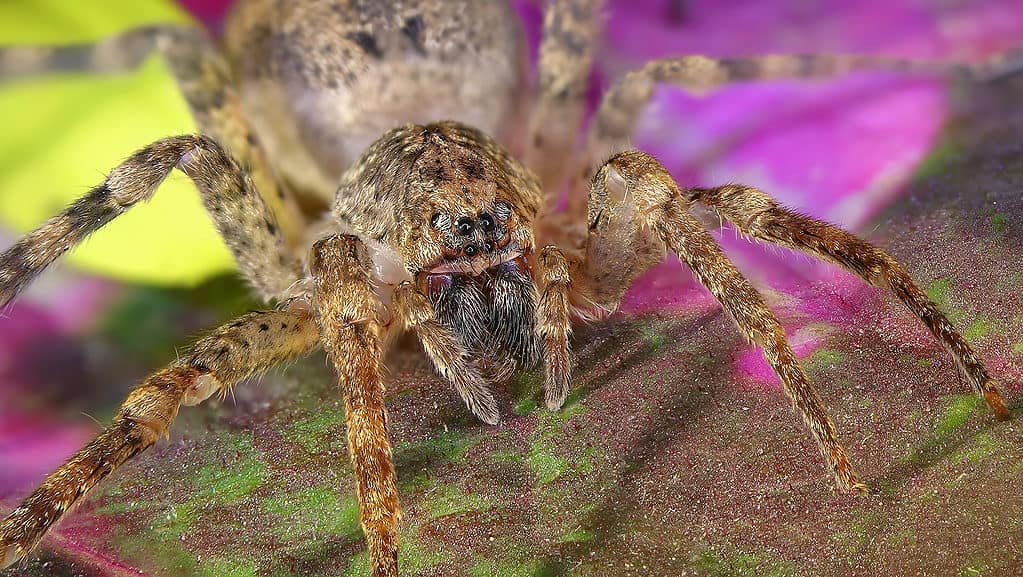
The giant
crab spider
is also known as the huntsman spider or cane spider.
©Protasov AN/Shutterstock.com
Olios giganteus, or the giant crab spider, is a member of the giant crab or huntsman spider family Sparassidae. It is one of the largest spiders in New Mexico and also ranges throughout much of the western United States and Mexico.
Adult specimens can reach up to 6 inches long with their legs extended. Meanwhile, their bodies usually measure around 20 millimeters long. They appear primarily light brown, black, tan, and orange. In general, their color tends to grow darker near the ends of their legs. Aside from their large size, you can identify them by the black Y-shaped marking on the abdomen.
Giant crab spiders actively hunt insects and other spiders instead of using webs to immobile their prey. They possess a reputation for acting aggressive, especially when guarding their eggs against predators. Additionally, their painful bite can often cause nausea, headache, and swelling.
#2. Brown Widow
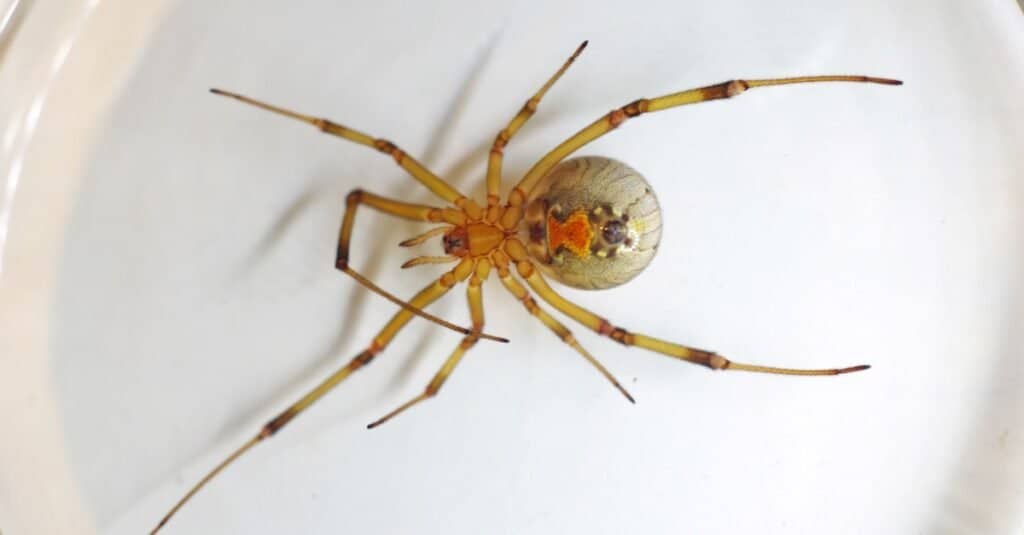
The brown widow spider has an hourglass pattern on the abdomen.
©Decha Thapanya/Shutterstock.com
The brown widow, Latrodectus geometricus, is one of the more poisonous spiders in New Mexico. It goes by many other names, including the brown button spider, grey widow, brown-black widow, and geometric button spider. While researchers believe it originated in Africa, it was first described in South America and is found throughout the world today.
Adult females measure 7 to 10 millimeters long, while males measure 2 to 4 millimeters long. They appear primarily tan or brown but also contain shades of grey. You can identify them by the black and white patterns on their sides and a distinctive yellow-orange hourglass-shaped marking on their abdomen.
While not as venomous as its cousin, the black widow, the brown widow still carries potent toxin. The reason why it’s not as dangerous is that it delivers less toxin per bite. The neurotoxins it carries can cause you to experience pain, redness, and swelling.
#1. Texas Orb Weaver
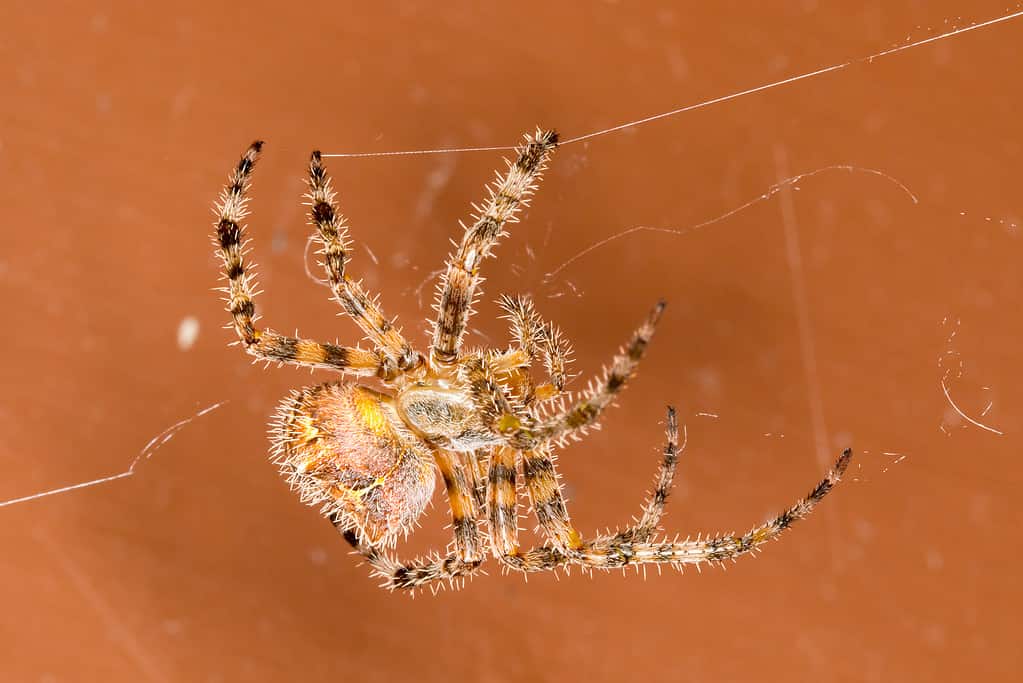
The Texas orb weaver is not only very large but also quite hairy.
©Elliotte Rusty Harold/Shutterstock.com
Araneus illaudatus is more commonly known as the Texas orb weaver. It is the second member of the family Araneidae to make our list of spiders in New Mexico. You can find it throughout the southwestern United States.
Female Texas orb weavers measure quite large and can reach up to 25 millimeters long. Meanwhile, the males measure significantly smaller at only 9 millimeters long at most. Their hairy bodies appear primarily off-white and sometimes sport a tinge of pink. They feature two distinctive triangular patches near the front of the abdomen with a white dot in the middle of each.
Like other orb weavers, they construct radial-style webs that they use to capture their prey. Despite their large size, their bite is not medically significant.
Summary of 10 Spiders in New Mexico
Here’s a recap of 10 spiders found in the state of New Mexico that we took a look at:
| Number | Spider | Scientific Name | Length |
|---|---|---|---|
| 1 | Texas Orb Weaver | Araneus illaudatus | Females: up to 25 mm; males: 9 mm |
| 2 | Brown Widow | Latrodectus geometricus | Females: 7-10 mm; males: 2-4 mm |
| 3 | Giant Crab Spider | Olios giganteus | 6 inches long with their legs extended; bodies typically are 20 mm |
| 4 | Chiricahuan Grey Tarantula | Aphonopelma gabeli | 5 inches but can reach up to 6 inches |
| 5 | Golden Silk Orb Weaver | Trichonephila clavipes | Female: 24-40 mm; males: 6 mm |
| 6 | Western Parson Spider | Herpyllus propinquss | 10-20 mm; females are larger than males |
| 7 | Geolycosa Missouriensis | Geolycosa missouriensis | 18-22 mm; females are larger than males |
| 8 | Desert Red Jumping Spider | Phidippus ardens | Females: up to 18 mm; males are slightly smaller |
| 9 | Tucson Bronze Tarantula | Aphonopelma virhiesi | 3-5 inches long with their legs extended; females tend to be larger than males |
| 10 | Southern House Spider | Kukulcania hibernalis | 50 mm with their legs extended; males have longer legs and females have more bulbous abdomens |
The photo featured at the top of this post is © Vinicius R. Souza/Shutterstock.com
Thank you for reading! Have some feedback for us? Contact the AZ Animals editorial team.



